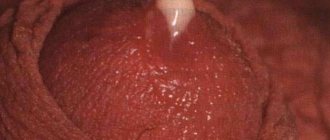General information
Intracranial hypertension is not considered an independent disease, but a syndrome that occurs against the background of another disease, trauma to the skull or circulatory disorders in the brain. Characterized by increased intracranial pressure.
There is a certain classification of hypertension depending on the characteristics of the pathology. It is established when specialists, based on the results of diagnostic and laboratory tests, have not established another reason for such changes.
Complications
The brain is a vulnerable organ. Prolonged compression leads to atrophy of the nervous tissue, which means that mental development and the ability to move suffer, and autonomic disorders occur.
If you do not contact a specialist in time, compression will occur. The brain may be forced into the foramen magnum or into the notch of the tentorium cerebellum. This compresses the medulla oblongata, where the centers of respiration and circulation are located. This will lead to the death of a person. Pressing into the notch of the tentorium is accompanied by constant drowsiness, yawning, breathing becomes deep and rapid, the pupils are noticeably constricted. Wedging of the hippocampal hook occurs, a symptom of which is dilation of the pupil or the absence of a light reaction on the side of the damage. An increase in pressure will lead to dilation of the second pupil, disruption of the breathing rhythm and coma.
High intracranial pressure is always accompanied by loss of vision due to compression of the optic nerve.
Classification of the disease
Depending on the characteristics of the course, intracranial hypertension is divided into several types. These include:
- Liquor. Refers to the most common types of pathology. It is characterized by an increase in the volume of liquor fluid, which is how it got its name.
- Venous. The cause of development is a violation of the outflow of blood through the veins. This occurs more often against the background of vasoconstriction or the formation of blood clots. In addition, experts believe that one of the triggers is increased pressure in the chest area.
- Idiopathic. Also called benign or primary. Is a temporary condition. It is characterized by an increase in intracranial pressure as a result of the influence of a number of unfavorable factors and tends to go away on its own.
Depending on the intensity of symptoms and the severity of the clinical picture, intracranial hypertension is divided into acute and chronic. In the first case, the disease has pronounced symptoms and has a severe course. In this case, the pressure has an abrupt character. As a result of the lack of timely treatment, the disease can lead to death. Therapy is carried out exclusively through surgery.
The chronic form does not manifest itself in the form of pressure surges and develops against the background of constant stress, depression and other neurological conditions. Therapy is carried out using medications and physiotherapeutic methods.
Causes of intracranial hypertension in adults
Changes in pressure are the result of various unfavorable influences. Impaired outflow of cerebrospinal fluid is provoked by the following etiological factors:
- Formation of a tumor in the cranial cavity. Neoplasms can compress both the brain itself and the vessels and lymphatic pathways that feed it. Such changes disrupt the process of fluid outflow, which leads to the occurrence of intracranial hypertension syndrome.
- A common cause of pressure changes is damage to the arteries and veins. Stroke is a dangerous condition accompanied by the development of ischemic processes in brain tissue. Intracranial hypertension may be a consequence of the hemorrhagic type of the disease.
- Formation of hematomas as a result of injuries. When large vessels or bones are damaged, compression of structures located in the cranial cavity is recorded. In addition, as a result of road traffic accidents, accidents or injuries received in the army, during combat operations, disruptions in the functioning of other organs are often observed, which only aggravates the manifestations of the lesion and increases bleeding.
- Inflammatory diseases of the brain and its membranes – encephalitis and meningitis. Viral and bacterial agents provoke inflammation of cerebral structures, which leads to an increase in their volume. Such changes disrupt the normal flow of fluid through the vessels in the cranial cavity, which leads to increased intracranial pressure.
- Heart failure, as well as end-stage renal damage. These structures control the overall level of pressure throughout the body. When their work is disrupted, patients often suffer from hypertension, including in the brain. Common consequences of such chronic problems are cerebral edema and intracranial hypertension.
- Obstructive pulmonary disease provokes changes in hemodynamics in the pulmonary circulation. This leads to a gradual increase in hypertension, which affects not only the functioning of the respiratory system, but also the function of all other organs. The brain also suffers. The situation is aggravated by an increase in hypoxia due to a decrease in the ability of the lungs to enrich the blood with oxygen.
In rare cases, intracranial hypertension can develop in the absence of damaging factors. A similar phenomenon occurs in children and adults; cases have been recorded in pregnant women. The condition is characterized by a relatively mild course and goes away on its own when exposure to negative factors ceases. This process is called “benign intracranial hypertension.”
Reasons for development
There are several reasons for the development of intracranial hypertension. First of all, this condition occurs against the background of a violation of the outflow of cerebrospinal fluid. Also, the development of unpleasant symptoms can be caused by changes in blood levels in the brain.
Among the causes of intracranial hypertension are:
- Neoplasms of various types. These include benign and malignant.
- Metastatic lesions formed in internal organs.
- Inflammatory diseases such as abscess, meningitis and encephalitis.
- Anomalies in the structure of the brain.
- Traumatic brain injuries. These include hematomas, concussions, and birth injuries.
- Cerebral circulation of acute and chronic forms.
- Poisoning with gases, metals, alcoholic drinks, waste products of pathogenic microorganisms.
- Pathologies of internal organs, as a result of which there is a violation of blood circulation in the veins of the cranium.
There are many reasons for the development of intracranial hypertension. At first glance, the benign form has no reason to arise. But this is far from true. The causes of its appearance can be constant stress, depression, and neuroses.
Idiopathic and chronic ICH
ICH can occur in two forms. However, the signs of intracranial hypertension and treatment methods will vary. The chronic form of the course is often caused by cancer or inflammation of the meninges. Ideopathic is called intracranial pressure that arose spontaneously, so doctors cannot accurately formulate a list of reasons that caused the pathological process.
Medical statistics show that benign intracranial hypertension appears most often in girls who are over 20 years old. According to doctors, it can be triggered by excess body weight, as well as metabolic or hormonal disorders.
Young girls with curvy figures are at risk of the disease
The idiopathic form of ICH can also result from:
- Previous systemic lupus;
- Cushing's syndrome (excessive amounts of adrenal hormones);
- Vitamin D deficiency in the body;
- Iron deficiency anemia (IDA);
- Hyperthyroidism (thyroid dysfunction);
- Advanced form of renal failure.
Sometimes the idiopathic form of ICH occurs against the background of long-term use of corticosteroid hormones. Especially often, pathology is diagnosed after abrupt cessation of taking these medications. Therefore, treatment with corticosteroid medications should be strictly under the supervision of the attending physician.
Main symptoms and signs
The main manifestation of intracranial hypertension is headache. It has a bursting and pressing character. Localized in the parietal region. The symptom is expressed more often in the morning, since the outflow of blood and cerebrospinal fluid worsens as a result of body position.
In addition, the pain becomes much stronger when coughing and sneezing, and can be accompanied by intense dizziness. Patients often complain of increased pressure in the eye area and noise in the head. Otherwise, the signs of intracranial hypertension in adults and children have certain differences.
In adults
In addition to headaches, symptoms such as nausea and vomiting begin to appear. They appear after eating, in the morning, or when the intensity of the headache increases. Symptoms of the disease also include:
- Increased fatigue. Even after minor physical exertion or mental stress, fatigue occurs after a short amount of time. In some cases, it is accompanied by tearfulness, psycho-emotional instability and increased irritability. Sleep disturbance is also noted.
- Visual impairment. Patients talk about double vision, pain with changes in atmospheric pressure, and fogginess.
- Increased heart rate.
- Increased sweating.
- A sharp change in blood pressure.
- Impaired performance of the autonomic nervous system.
- Increased sensitivity to changes in weather conditions.
- Impaired consciousness.
- Cramps.
In severe cases, coma occurs. In the idiopathic form of intracranial hypertension there is no nausea and vomiting. But signs such as loss of consciousness and lethargy occur.
In children
In newborns, intracranial hypertension occurs as a result of birth trauma or impaired fetal development. The main signs in children under 12 months of age are:
- Pulsation and swelling of the fontanelle.
- Cramps.
- Moodiness.
- Constant anxiety.
- Lethargy or excessive activity.
- Decreased appetite.
- Constant sleepiness.
- Frequent regurgitation and vomiting.
- Decreased muscle tone.
The baby may also confuse the time of day. As the volume of the head increases, pressure readings also increase, which is accompanied by hydrocephalus. Children experience neurasthenia, headaches, and constant loss of consciousness.
If symptoms occur, you must immediately consult a doctor, since the lack of adequate and timely treatment leads to serious consequences, including death. That is why identified intracranial hypertension requires immediate treatment.
Pathogenesis
The human brain is located inside the cranium - it is a closed space with rigid walls, in which approximately 80% of the volume is occupied by the brain matter itself, about 15% is cerebrospinal fluid, and the remaining 5% is drained by blood. Cerebrospinal fluid (CSF) is produced in special choroid plexuses; it constantly circulates between the ventricles of the brain and the subarachnoid space, where it is absorbed into the venous sinuses. Liquor performs a protective and nutritional function, and also creates a certain pressure on the walls of the skull and brain structures.
Normally, ICP (intracranial pressure) is not felt by a person; its value ranges from 3 to 15 mm Hg. Art. When coughing, straining, lifting heavy objects or screaming, a short-term increase in ICP may occur, which disappears after the person returns to its original state.
A persistent and prolonged increase in ICP leads to the exhaustion of the body's compensatory capabilities, and chronic intracranial hypertension develops. This happens when the normal relationships of all components of the cranium are disrupted (for example, due to an increase in the amount of cerebrospinal fluid, disruption of venous outflow, the appearance of edema or pathological volumes in the brain substance, etc.). It is impossible to measure intracranial (intracranial) pressure under normal conditions, unlike blood pressure; this can only be done during a neurosurgical operation or during a spinal puncture.
A pronounced increase in pressure in the confined space of the skull causes the development of a condition called intracranial hypertension syndrome. This pathology is dangerous because, as a result of compression of the medulla, a disorder of metabolic processes in neurons develops; dislocation (displacement) of individual brain structures can occur, up to the wedging of the cerebellum and medulla oblongata into the foramen magnum, with subsequent disruption of vital functions.
Diagnostics
In cases where a specialist suspects the presence of intracranial hypertension, a number of instrumental diagnostic methods are prescribed.
First of all, the neurologist measures the pressure inside the skull. The complexity of the technique lies in the fact that today there is no simple method. All data obtained using echo-encephalography are approximate and are assessed in accordance with the clinical picture.
Helpful information
Also, the presence of the disease is determined by the results of a lumbar puncture. The procedure is carried out by inserting a needle into the cerebrospinal fluid space and collecting cerebrospinal fluid.
A neurologist also performs an examination. Intracranial hypertension is accompanied by papilledema. Such changes are established using ophthalmoscopy. The condition of the bones of the skull and nerve endings is also assessed. For this purpose, an x-ray examination is prescribed.
The doctor conducts a study aimed at assessing the tone of muscle tissue, gait, psycho-emotional state, and sensitivity.
To determine an accurate diagnosis, the following methods are used:
- CT scan. Thanks to layer-by-layer scanning of tissues, it is possible to determine the size of the ventricles of the brain and the presence of hemorrhages.
- Magnetic resonance imaging with contrast agent. It is used to color the vessels in the image, which allows you to identify areas of circulatory disorders.
- Neurosonography. Used to study newborns.
Intracranial hypertension is established after studying all research results. Only a specialist can determine an accurate diagnosis.
Methods of combating the disease
The method of treating the disease depends primarily on the causes of its occurrence, as well as on the symptoms.
Based on this information, a treatment plan for the disease is usually formed. Treatment should always be comprehensive. It often consists not only of drug therapy, but also of lifestyle changes (especially if cerebrospinal fluid hypertension is caused by obesity). Surgical intervention is already a last resort if conservative treatment does not bring the expected results.
Basic treatment methods
Treatment directly depends on the reasons that led to the occurrence of this disease. First of all, it is necessary to eliminate these provoking factors, so therapy is primarily based on these points - to cure these ailments. If this was caused by a tumor or hematoma, then you will probably still have to resort to surgery. Almost always, a decision is made in favor of removing the tumor in order to save the patient’s life. If the cause is a congenital defect, then sometimes it is necessary to install special shunts to facilitate the unhindered drainage of cerebrospinal fluid.
In other cases, the following actions are taken to directly reduce intracranial pressure:
- prescription of diuretics. To remove excess fluid from the body;
- antibacterial therapy. If the problem is provoked by infectious praise (meningitis);
- special physical exercises that will help relax the neck muscles, which will further promote normal outflow of cerebrospinal fluid.
Ways to prevent the development of the disease
Preventing the development of the disease consists, first of all, in preventing the development of diseases that are provoking.
You should also try to avoid brain injuries. Hypertension should be detected and treated promptly. If a person knows that he has a predisposition to the development of such diseases, then all provoking factors must be eliminated as much as possible:
- control body mass index;
- watch your diet;
- to live an active lifestyle;
- avoid swelling (do not consume foods that delay the removal of fluid from the body).
Possible complications
The treatment of this disease must be approached with all seriousness, since in the absence of adequate effective therapy, many serious complications can develop. It is not always possible to prevent the disease even if all necessary measures are taken - no one is immune from injuries and falls, after which hematomas may occur, so in this case it is necessary to immediately begin treatment. The brain is a very important organ that performs many functions. But at the same time, if it remains in a compressed state for too long, then very soon it will cease to properly perform its functions.
The brain matter then begins to die, gradually provoking irreversible processes in the body. Initially, a person’s mental abilities deteriorate significantly, and intelligence decreases significantly. At later stages of the development of such complications, disruption of the functioning of internal organs is possible. Also, such a phenomenon as increased intracranial pressure leads to rapid atrophy of the nerves, as a result of which the patient very quickly loses vision.
Compression of the brain substance is dangerous not only for the patient’s quality of life, but can also directly lead to his death. For example, if the brain is compressed for a long time, it can not only stop functioning properly, but also shift into the openings of the skull. This entails compression of vital centers (responsible for breathing and other important processes) and quick death.
The sooner treatment is started, the greater the chance that a person will be completely cured of the disease. But the chances are higher, the less compression was applied to the brain tissue. In addition, in any case, the faster the provoking factor is identified, the easier it will be to eliminate it.
Treatment
The course of therapy is selected by a neurologist based on research results and examination data. Also of particular importance is the reason why the pressure inside the skull increased.
Treatment of intracranial hypertension is aimed at removing excess cerebrospinal fluid in the skull and relieving symptoms. Therapy is carried out comprehensively. Medicines and physiotherapy are prescribed. In severe cases, the specialist decides to perform surgical intervention. The main reason for the increase in pressure inside the skull is also treated.
Drug treatment
Drugs are prescribed according to the clinical picture and development factors. The main drugs are diuretics. They are selected by the doctor depending on the severity of the patient’s condition. In severe cases, Mannitol is used. It is also necessary to take medications containing large amounts of potassium. The dosage and duration of use are determined by a neurologist.
If side effects occur, you should consult a specialist. He will choose another drug. Self-medication is strictly prohibited. This can cause serious consequences.
Based on the clinical picture, general condition and characteristics of the course of the disease, the following drugs can be prescribed:
- Hormonal. Should be taken only as prescribed by a neurologist. You should also not stop taking it yourself, as certain side effects may occur.
- Neurometabolic. These include Piracetam, Glycine and others. They are used to maintain the functioning of the nervous system.
- Antiviral.
- Antibacterial.
- Vasoactive. Prescribed when intracranial hypertension is accompanied by vascular disorders.
- Venotonics. Used to detect stagnation of blood in the veins.
It is important to take all medications only in the indicated dosage. It is also prohibited to cancel them or increase the amount of active substances, as this can lead to serious consequences.
Physiotherapy
When intracranial hypertension is detected in children or adults, physiotherapeutic methods are often prescribed. They help relieve blood stagnation, normalize cerebrospinal fluid circulation and improve the metabolic process.
A low-salt diet has shown good results for this disease. It is also recommended to maintain a drinking regime. Among the additional methods of therapy, the most effective are:
- Exercise therapy. A set of specially selected exercises allows you to reduce blood pressure and relieve pain.
- Massage. Used to improve blood circulation in the cervical region.
- Acupuncture. The procedure should only be carried out by a specialist. It is carried out by using special thin needles that are installed at certain points on the body.
Electrophoresis with lidase shows good indicators for increased pressure inside the skull. The procedure is carried out using electric current. At the same time, the medicine is administered subcutaneously.
Surgical intervention
In severe cases of intracranial hypertension, surgical intervention is more often prescribed. It is used when drug therapy does not bring positive results. Indications for surgery are a sharp decrease in intracranial pressure and a high risk of dislocation syndrome.
When identifying intracranial hypertension, which is accompanied by certain diseases and has a severe course, the following surgical methods are used:
- Trepanation of the skull. Allows you to reduce pressure levels. But the procedure often causes infection.
- Ventricular drainage. The specialist makes a hole in the skull through which the tube is inserted. It is used to remove accumulated cerebrospinal fluid in the ventricles. Used for cerebral hemorrhage.
- Cerebral shunting. The shunt is a hollow tube. The entire system consists of several parts. After it is installed in the ventricle of the brain and removed, the liquor fluid is discharged into a special cavity, where it is subsequently absorbed.
The method of surgical intervention is selected by the attending physician depending on the characteristics of the pathology, the severity of the disease and the general condition of the patient.
Liquor and its functions
To understand all the concepts and processes associated with intracranial pressure, you should first consider the concept of cerebrospinal fluid. Liquor is called cerebrospinal fluid, which consists of cellular elements, protein structures, water and circulates in the ventricles of the brain and the spinal canal.
Liquor ensures the normal functioning of brain tissue. It has several important functions:
- protection of the spinal cord and brain from mechanical influences (shock absorption);
- removes waste products of nerve cells;
- a composition with a certain concentration of electrolytes and pH level creates favorable conditions for the stabilization of brain tissue and normal excitability of nerve cells;
- transports biologically active substances, hormones, oxygen;
- is a natural immunobiological defense.
The volume of cerebrospinal fluid ranges from 400 to 600 ml, its composition is similar to blood serum: 90% water, slightly alkaline medium. There are small amounts of proteins, electrolytes, glucose, amino acids, and lipids. The amount of cerebrospinal fluid regulates intracranial pressure. And to keep the pressure on the membranes of the brain within normal limits, doctors recommend drinking about 1.5 liters of water daily.
Consequences
The consequences of intracranial hypertension depend on:
- from the individual reactions of the body;
- duration of the pathology;
- the reasons that caused the pathology;
- and also on how early treatment was started.
If we are talking about idiopathic (benign) hypertension, then its outcome is always favorable. This type of pathology is well treated, the symptoms go away quickly, and the brain is not damaged.
The acute form of cranial cerebrospinal fluid hypertension can lead to death.
The chronic form of increased intracranial pressure in childhood is fraught with delays in mental and mental development. The most dangerous condition is oligophrenia.
With intracranial hypertension, intracranial pressure increases, resulting in incredible compression on the brain. It can cause tissue atrophy. Consequently, a person’s intellectual abilities will decrease, and after prolonged compression, the nervous regulation of the activity of internal organs will be disrupted.
If therapy is not started in time, constant compression of the brain can lead to its displacement and even wedging into the cranial openings. In such a situation, there is a high probability of falling into a coma, and even death.
Complications of ICH in children should be taken especially seriously. The fact is that the brain, compressed for a long time, stops developing. As a result, mental retardation, moronism, and mental retardation appear.
Intracranial hypertension leads to disruption of brain activity and the peripheral nervous system, this may cause a delay or complete exemption from military service.
How to relieve pain?
For prevention, it is recommended to perform a head massage. It will not only help prevent disease, but also relieve pain and increasing pressure.
Also, to reduce headaches, which often accompanies an increase in intracranial pressure, you can use a magnesium-based recipe. The product has a pronounced diuretic effect, due to which the pressure on the brain structures is reduced and pain is removed.
For 50-80 g of hot boiled water you will need a tablespoon of magnesium sulfate in powder form. When it is completely dissolved, the drink must be drunk at once. After 5 min. After taking the medication, you need to take fish oil, which will make it possible to prevent excessive blood thickening.
Folk remedies against increased intracranial pressure
If intracranial hypertension is accompanied by mild symptoms and the pathological condition does not progress, the problem can be solved with the help of various medicinal herbs. A decoction of mulberry berries gives a good effect. To prepare this product you need to take 1 tbsp. berries per 1 liter of water. The resulting mixture should be boiled and left for 6 hours. After straining, the decoction should be taken 3 tbsp. in a day.
A decoction of poplar buds significantly helps reduce intracranial pressure. To prepare this remedy, you need to boil approximately 20 g of buds in a glass of water for 15 minutes. After this time, the broth should be filtered, diluted with clean water and drunk throughout the day.
To reduce the manifestations of increased intracranial pressure, you can use the herbs of hawthorn, mint and valerian. Considering that intracranial hypertension is extremely dangerous, you should first discuss with your doctor the advisability of using folk remedies to correct this condition.
Prevention
Preventive techniques are actively used in rehabilitation. This allows you to prevent the re-development of pathology, complications and exacerbations.
Prevention of ICH includes:
- diet,
- reducing fluid intake, including injections,
- treatment of respiratory organs,
- refusal of vasodilators, alcohol and drugs,
- increasing the angle of the pillow.
Strict adherence to instructions and prescription promotes speedy recovery and recovery.
Diet and lifestyle
To make the disease easier to bear, it is necessary to relieve symptoms. To do this, you need to remove provoking factors. This can include nervous and physical stress, air travel, climbing mountains, viral infections and common colds, as well as alcohol abuse and smoking.
Patients with ICH are advised to reconsider their lifestyle. You need to adhere to the correct daily routine, going to bed and waking up at the same time. Rest should be complete. Moderate activity and walks in the fresh air will have a beneficial effect.
Patients are prescribed a salt-free diet. It is necessary to remove excess liquid. Salt should be excluded from the diet; the body will receive it in sufficient quantities from bread and other foods. You should also avoid fast food, carbonated drinks, canned food, and smoked foods. It is necessary to regulate watching television, working at the computer, and using headphones.
A diet aimed at removing fluid from the body, proper rest, and giving up bad habits will help you quickly cope with the disease.
First aid
If intracranial pressure increases rapidly, the patient's life is in danger. In this case, resort to urgent first aid measures for liquor hypertension. Thus, it is recommended to administer hyperosmolar solutions into a vein, emergency intubation and artificial ventilation of the lungs in hyperventilation mode. In some cases, the patient is put into a medically induced coma (with the help of barbiturates). Using a puncture, excess amounts of cerebrospinal fluid are removed. The most aggressive measure is decompressive craniotomy. It is only done in extreme situations. The essence of the procedure is to create a defect in the skull on one or both sides so that the brain does not “rest” against the bones of the skull.











